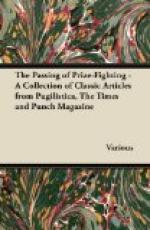* * * * *
The Unspeakable Perk (HODDER AND STOUGHTON) and his attendant puppets are, to put it kindly, selected from the stock characters of Lesser American Fiction. There is the “radiant” heroine from Squeedunkville, Wis. (or Mass.); the tame Poppa with the simoleons, the hero heavily disguised as a worm, and a worm or so to do the real heavy worming when the hero’s turn comes to pull off the grand-stand play (this doesn’t sound like English but it is really the standard “line of talk” in Lesser American Fiction). And last but not least there is the “fiery” Southerner. In real life Southerners are melancholy men with a tendency to embonpoint and clawhammer coats of ante-bellum design. But in Lesser American Fiction they are for some undiscovered reason always “fiery.” To the fiery one the heroine “unconsciously turns” when the apparent earmarks of the hero’s wormhood are dramatically revealed, and of course she hands him what she would probably describe as the “sister” stuff when the gentleman emerges in his natural colours. That is what makes the story-book Southerner so fiery. Place these complex characters in an imaginary Carribean Republic, a sort of transpontine Ruritania; add a revolution fostered by the serpentine diplomats of a European power; let the American eagle issue a few screams, and there you have the environment in which The Unspeakable Perk lives and moves and has his unreal being. The keynote of SAMUEL HOPKINS ADAMS’ story is what the Perk person would describe as a want of “pep.” Even the villains turn out to be comparative gentlemen in the end, the dirty work being conveniently fastened upon some “person or persons unknown.” The yarn is well enough to wile away an hour; but in these days of burning realities fiction has lost its bite unless it too is informed with the spirit of reality.
* * * * *
I have to warn you that the early chapters of The Moulding Loft (METHUEN) are liable to plunge you into some mental agitation, due to the author’s deliberately baffling method of starting her plot. The hero, for example, is introduced to us abed, and semi-delirious, waited upon by a pale and sinister young female whom he detests. He appears to be in a house strange to him, which contains also an unpleasant old woman and a queer little boy whose behaviour is wrop in mystery. Slowly, perhaps somewhat too slowly, it is revealed that the hero has been knocked silly by a large stone dropped upon his unoffending head by the small boy. But why? And why does the child protest his innocence with such apparent good faith? These problems I must leave MARGARET WESTRUP (Mrs. W. STACEY) to resolve in her own unhurried way. Of course before long the “little aversion” between hero and heroine gives place to an emotion more appropriate. But there remains an obstacle to their union, one concerned (also, of course) with the detestable grandmother




